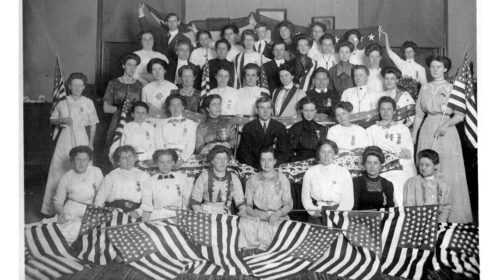Pennsylvania was a center of women’s rights activism from the mid-1800s through the early 1900s. Following the Civil War several western states and territories passed laws granting women the right to vote; however, when Philadelphia’s Carrie Burnham attempted to vote in 1871, she was arrested and ultimately lost her case before the Pennsylvania Supreme Court. Despite strong lobbying by women, eastern states resisted their efforts, and every referendum and resolution introduced at the state level either failed in the legislature or was defeated by voters.
Between 1910 and 1914 eight more western states and the territory of Alaska passed legislation granting women the right to vote, bringing the total to 19. Inspired in part by what was happening in state legislatures in the west, a new generation of feminists launched a final push to achieve voting rights in all states. Countless Pennsylvania women worked tirelessly to spread the suffrage movement across their state. An amendment to the state constitution granting women the right to vote passed the state legislature in 1913 and went on the ballot for voter ratification in 1915. It faced strong opposition from the liquor and textile industries.
The Pennsylvania Woman Suffrage Association organized a campaign for passage of the referendum that took them to every county in the state. They funded the creation of the Justice Bell, an exact replica of the Liberty Bell but without the crack and with the words “establish justice” added above the inscription. The Justice Bell toured Pennsylvania in 1915 to win support for the state amendment. Its clapper was secured with chains so that it could not ring until women had won the vote.
During the five months leading up to the election, the “Women’s Liberty Bell” visited all 67 counties. Displayed on the open bed of a pickup truck, the bell was met with enthusiastic crowds wherever it went. For more on the route of the Justice Bell through Wayne, Pike and Monroe Counties, visit the GDHS YouTube channel and view The Road to Women’s Suffrage Traveled Through Newfoundland and Greentown. The bell was expected to ring out in victory in Philadelphia once the 1915 election results came in. Wayne County joined other northern and western counties to vote in favor of the state amendment, while Pike County, along with the southeastern and central counties, led by Philadelphia, voted against. The referendum went down in defeat, and the Justice Bell stayed silent.
After the United Stated entered World War I in 1917, the women’s suffrage movement shifted its focus from the state to the national level. Women from across the country silently protested and picketed in the nation’s capital for months, until police began making arrests. While in prison many women joined in hunger strikes, and the public became horrified by their harsh treatment. Sympathy began to swing in their direction.
On January 10, 1918, Jeannette Rankin of Montana, the first female member of Congress, introduced the suffrage amendment on the floor of the House. It passed by one vote more than the two-thirds majority required. It took another year and a half for it to win passage in the Senate. In June 1919, the amendment was submitted to the states for ratification. Pennsylvania acted quickly, ratifying the historic Nineteenth Amendment to the United States Constitution on June 24, 1919.
During the long months of waiting for the states to ratify the 19th Amendment, the Justice Bell, accompanied by members of the Pennsylvania Woman Suffrage Association, toured other states. Finally, their dedication paid off. Women’s suffrage became the law of the land in August 1920 when Tennessee became the 36th state to ratify the amendment. The Justice Bell rang for the first time on September 25, 1920. Thousands gathered in Philadelphia’s Independence Square to watch as the clapper was unchained and rung 48 times. Pennsylvania women voted for the first time later that fall.
The Justice Bell permanently resides in the bell tower at the Memorial Chapel in Valley Forge National Park, where it remains on public exhibition.
